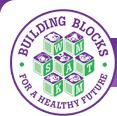 |
|
 |

Portion Control
Normal, healthy toddlers and preschoolers are pretty good judges of how much they need to eat. They’ll often stop eating before they clean their plates. Does this mean they’re not eating enough? Or, does this mean we are serving them too much?
- Eating by measure is a great way to use dietary guidelines for proper child nutrition. You and your child should look for nutritional information on all packaged foods. What is a “serving size”? How much is that?
Try it:
If a serving size of shelled walnut pieces is one-fourth of a cup, get out the measuring cup and have your child fill it to the one-fourth mark. Then, pour out the nuts and count them. How many nuts is a proper portion for an adult? If you take away one-third or one-half of those nuts, how much is a proper portion for a preschooler?
Talk about it:
Is the number of nuts you or your child normally eats for a snack more or fewer than the portion-controlled amount? What nutritional change could you make in your family’s diet?
- Do you give your child too much food and have to throw it away later? Does your child say “I’m full” when there’s still food on the plate? Do you insist he/she eats more? Maybe you’re just not sure of how much food to put on your child’s plate. For a few days, measure how much your child eats before he/she says “I’m full” or “I don’t want any more.”
Try it:
You and your child can measure the serving size you normally serve. If it pours, put it in a measuring cup; if it’s solid, use a ruler; or if you have a food scale, weigh it. Write down the amount, then serve it. When your child says “I’m full,” measure what’s left over and subtract.
Think about it:
How much was too much for your child’s plate? Next time, put on the plate only the amount your child ate. Children will ask for more if they’re still hungry. Let your child decide when enough is enough.
- The American Diabetic Association has developed a “Hunger Scale” for children who are overweight. We have adapted this scale for your preschooler.
1 = I’m so hungry. I have to eat something right now.
2 = I’m hungry and ready to eat (breakfast, lunch, dinner, or snack).
3 = I’m not hungry anymore.
4 = I’m full and want to stop eating.
5 = I’m stuffed and my tummy hurts.
Try it:
Have each family member tell where they stand on the scale before they eat and again when they stop eating.
Think about it:
Are the portions your family eat under control? Do family members eat snacks when they’re not hungry? Do family members stop eating when they’re not hungry anymore? Does your family have healthy eating habits when it comes to portion control?
|
 |


 About Us
About Us  Links
Links  Get E-mail Updates
Get E-mail Updates  Awards
Awards



